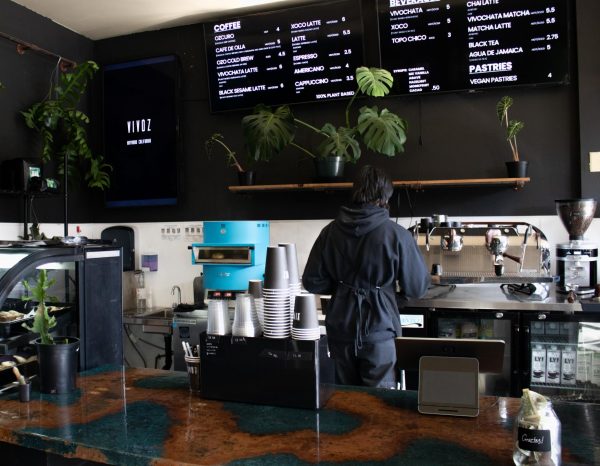Students Need Not Apply: A Revolution in Higher Education
February 15, 2023
Can you guess which article was written by ChatGPT?
For students, the premise of machine-based text generation may seem alluring, especially when artificial intelligence is capable of doing so with compelling prose and impeccable syntax while requiring minimal input from the user. On the other hand, educators have not viewed the technology with skepticism, citing concerns over plagiarism, loss of student agency, and the erosion of critical thinking skills as primary reasons for rejecting these novel tools in the classroom.
Text-generating AI programs became a source of scandalous academic discussion with the release of ChatGPT — a free AI-powered chatbot developed by San Francisco-based AI research company, OpenAI — in late November of 2022. Unlike many of its predecessors that rely on finite sets of pre-determined outputs, ChatGPT is unique in its ability to generate original, relevant responses and emulate human speech and writing patterns.
“[AI applications have] two main components: the model and the database,” explained Dr. Roger Wen, Senior Director for Online Campus and educational technologist at California State University, East Bay. Equipped with deep-learning algorithms and access to vast databases, ChatGPT is capable of learning at an exponential rate by analyzing past conversations, refining its answers based on user feedback, and storing that information for future reference.
Given its flexibility, ChatGPT can perform an impressive array of tasks, such as drafting and editing text, compiling and reviewing code, and delivering accurate answers to questions instantaneously. As a result, the versatility of the program has led to an enthusiastic reception among students, who may use ChatGPT as a convenient way to supplement or even offload their work onto the bot.
Though ChatGPT may merit some suspicion, Wen believes this new wave of AI to be the “beginning of an exciting technology” and urges educators to harness the technology, rather than shun it: “[Change] happens in our society and we have to embrace it.” Similar to the classroom prohibitions of calculators and laptops in the past, academic institutions adapted by integrating these technologies into their curriculums. To Wen, ChatGPT is no different.
While the artificial intelligence behind ChatGPT may seem disruptive and rather avant-garde, traces of AI have already been implemented on our East Bay campus. PioneerChat — which provides general student help, another CSUEB-based AI pilot application launched in 2017 that provides tutoring and assessments for certain courses and subjects, and finally the Repondus lockdown monitor. “Respondus already has AI components built into it, alerting the instructor [of potential cheating] if a student had their head too low [on camera],” revealed Wen. Hence, education standards are anything but stagnant, evolving piecemeal by piecemeal.
While the pandemic continues to force schools towards distant learning, ChatGPT can help facilitate remote learning. Wen views this crucible time as an opportunity to shift away from convention, rethink assessment methods, and enable students to take charge of their education as AI becomes smarter: “Students can learn anywhere and in any way they want to,” stated Wen, inviting instructors to “chunk assignments, encourage original work, [and] work with ChatGPT to promote critical thinking” as a way to promote a personalized, flexible learning environment.
While ChatGPT may be used as a vessel for cheating, developing AI-text detection services and implementing safeguards — such as Princeton student Edward Tian’s ‘GPTZero’ app — are likely to curb the rate of academic dishonesty upon full release, allowing AI applications the opportunity to be properly utilized as education-facilitating tools, rather than a crutch. Until then, Wen advises faculty to keep an open mind, learn how to use ChatGPT, and explore the possibilities of using AI as an education enhancement tool.
—
ChatGPT — the language model and free chatbot developed by San Francisco-based artificial intelligence company OpenAI — is changing the way people communicate and learn in the modern world.
While students are drawn to the idea of machine-generated text because of its ability to produce high-quality writing with minimal effort, educators have raised concerns about the potential for plagiarism, loss of student initiative, and decline in critical thinking skills. With ChatGPT exploding in popularity since its release in late November of 2022, the application has sparked a heated debate in the academic community.
What makes ChatGPT special is the way the chatbot is configured. “[AI text applications have] two components: the model and the database,” explained Dr. Roger Wen, Senior Director for Online Campus and educational technologist at California State University, East Bay. Unlike earlier chatbots that only offer a list of preset responses, ChatGPT can generate original and relevant outputs and mimic human speech patterns due to its deep-learning algorithms and access to a vast corpus of data that allows it to learn and improve over time. This versatility has made ChatGPT a popular tool among students, who can use it to assist them in their work or complete it on their behalf.
While some instructors look upon ChatGPT with scorn, Wen sees the introduction of ChatGPT as the start of a promising new era in technology and encourages educators to embrace it instead of rejecting it: “[Change] happens in our society and we have to embrace it,” stated Wen, comparing current resistance to ChatGPT to the initial skepticism towards other technologies — like calculators and laptops — that were eventually integrated into curriculums.
For example, Wen points out that AI has already been incorporated into the East Bay campus through programs like PioneerChat and the Respondus lockdown monitor. He notes that “Respondus already has AI components built into it, alerting the instructor [of potential cheating] if a student had their head too low [on camera].” Wen’s examples demonstrate that education standards are not set in stone and can change to adapt to new technology.
With the pandemic causing widespread disruptions to traditional education models, ChatGPT can help to democratize access to education. By providing quick and accurate information on a wide range of topics, ChatGPT is making it possible for students from all walks of life to gain the knowledge and skills they need to succeed in their academic and professional pursuits. This is especially important for students who live in remote areas, who may have limited access to physical classrooms, or who have disabilities that make it difficult to attend in-person classes.
For Wen, the goal of education should be to nurture creativity, critical thinking, and intellectual curiosity, and ChatGPT could play a crucial role in achieving this. By embracing the change that AI brings, higher education can move towards a more personalized and flexible learning environment. “Students can learn anywhere and in any way they want to,” said Wen, suggesting “chunk assignments, encouraging original work, [and] working with ChatGPT to promote critical thinking” as strategies to help students take charge of their education, learn at their own pace, and receive support from the AI when needed.
Of course, ChatGPT is not without its challenges, but with the development of AI-text detection services and the implementation of proper safeguards, higher education can harness the power of this technology to enhance the learning experience. It is up to educators to keep an open mind, learn how to use ChatGPT, and explore its potential to promote critical thinking and creativity in students.















